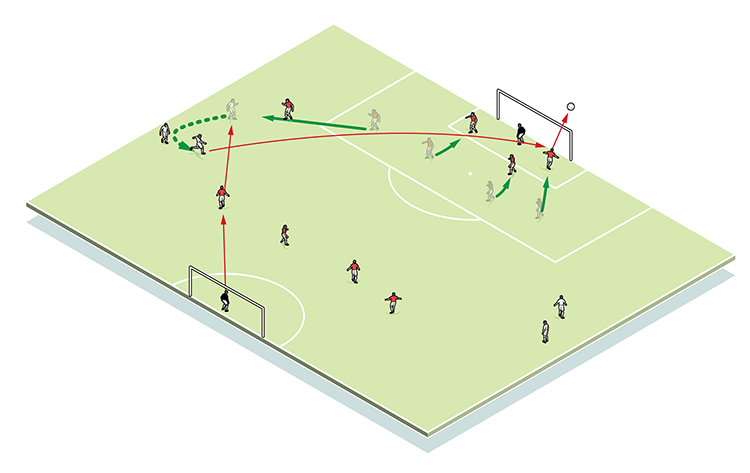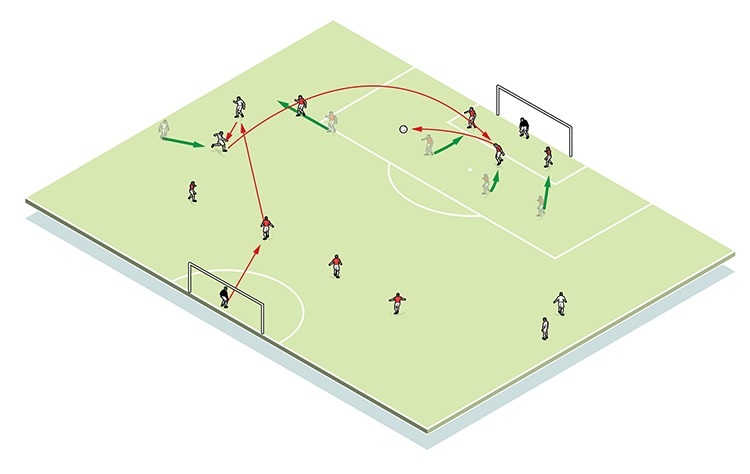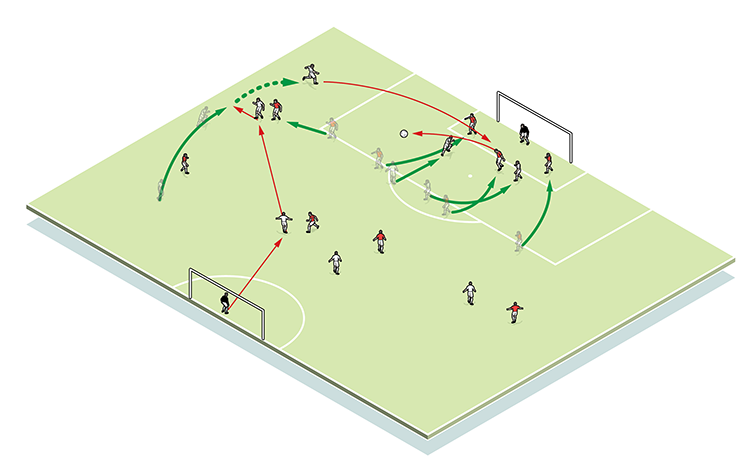You are viewing 1 of your 1 free articles
Defending crosses
This session enables defenders to learn how to best to repel a number of different crosses into the box. We test defensive strength against four different deliveries – an inswinging cross, and outswinging cross, a cross that’s laid back on the wing, and a second phase cross.
| Area | Half pitch |
| Equipment | Balls, goals |
| No. of Players | Full squad |
| Session Time | Crosses 20 mins, game 20mins |
This session enables defenders to learn how to best to repel a number of different crosses into the box. We test defensive strength against four different deliveries – an inswinging cross, and outswinging cross, a cross that’s laid back on the wing, and a second phase cross.
It’s crucial we practise this because, in matches, most goalscoring opportunities arise from crosses into the penalty area. Therefore, preventing and dealing with this threat is a key aspect in ensuring we keep clean sheets.
What do I get the players to do?
On a half pitch, there are two attacking wingers on each flank and, at each end, four defenders – two centre-backs and two full-backs – a keeper and a goal. Once each crossing phase is complete, it’s rerun on the opposite flank.
Outswinging cross
For this phase, the full-backs must stay in the box. The keeper plays out to the left wing, a winger takes the ball on, advances, then sends an outswinging cross into the penalty area (1a).
1a

Second phase cross
Immediately, the coach feeds the ball to the opposite flank as soon as the first cross is cleared (1b).
1b

Inswinging cross
Full-backs can now press, with the keeper playing out to a defender, who supplies a left winger. He checks back, then makes an inswinging right-footed cross into the area (2).
2

‘Lay back’ cross
Here, a winger touches the ball back for his team mate to make either an inswinging or outswinging cross (3).
3

Free cross
Finally, wingers combine to send over a cross of their choice.
What are the key things to look out for technically/tactically?
Defenders must ensure they remain in their designated areas, opening out to a 45 degree angle to give themselves the best chance of seeing what’s around them.
Defenders must be positive in their clearances, making a solid first contact that offers height and distance. They follow out, ready to regroup for any second phase crosses.
The full-backs’ task is to engage wingers and restrict wing threat.
How do I progress the session?
In progression, centre-backs now handle the threat of active forwards, while wingers can create one-two interplays, which threaten to pull full-backs out of position.
How do I put this into a game situation?
The session progresses into a continuous 8v8 game, with an emphasis on balls to the wing. A full-back must defend well whilst also supporting his attacking winger (4).
4

Related Files
Editor's Picks
Intensive boxes drill with goals
Penetrating the final third
Creating and finishing
My philosophy
Pressing initiation
Compact team movement
Defensive organisation
Back three tactics
Counter-pressing as an offensive weapon
Coaches' Testimonials

Alan Pardew

Arsène Wenger

Brendan Rodgers

Carlos Carvalhal

José Mourinho

Jürgen Klopp

Pep Guardiola

Roy Hodgson

Sir Alex Ferguson

Steven Gerrard
Related
Coaches' Testimonials

Gerald Kearney, Downtown Las Vegas Soccer Club

Paul Butler, Florida, USA

Rick Shields, Springboro, USA

Tony Green, Pierrefonds Titans, Quebec, Canada
Join the world's leading coaches and managers and discover for yourself one of the best kept secrets in coaching. No other training tool on the planet is written or read by the calibre of names you’ll find in Elite Soccer.
In a recent survey 92% of subscribers said Elite Soccer makes them more confident, 89% said it makes them a more effective coach and 91% said it makes them more inspired.
Get Monthly Inspiration
All the latest techniques and approaches
Since 2010 Elite Soccer has given subscribers exclusive insight into the training ground practices of the world’s best coaches. Published in partnership with the League Managers Association we have unparalleled access to the leading lights in the English leagues, as well as a host of international managers.
Elite Soccer exclusively features sessions written by the coaches themselves. There are no observed sessions and no sessions “in the style of”, just first-hand advice delivered direct to you from the coach.








